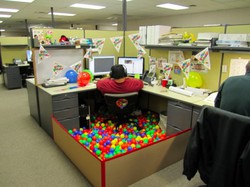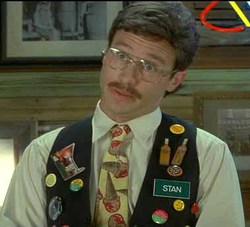More strange is that corporate management consultants have, especially since the mid 1990s, been debating the same thing. At first glance this is a bit strange: one can imagine why a communist would want to reconceptualize work as something other than wage-labor, but why does a capitalist have a problem with it, and find it in need of a revamp? Instead of trying to organize the workplace as a game, why not just organize it like a workplace, and, you know, pay people to do a job? The two main reasons seem to be: 1) a hope that there exist non-monetary incentives that elicit additional labor (to avoid having to pay out as many monetary incentives); and 2) a worry that certain kinds of productivity are simply impossible to monetarily incentivize, and instead require somehow producing intrinsically motivated, happy workers.
A frustrating aspect of getting a hold on this area is that, since a good portion is driven by short-term trends in the marketing and business-management industries, a new term seems to be coined every few years, with some shifts in the accompanying concept, and little reflection is done on how today's approach relates to yesterday's. I haven't worked it out myself, though I admit to skepticism; but here I'll simply collect a briefly annotated list of some sources, pro and con.
Partial list of references

Things largely seem to kick off with 1997's 301 Ways To Have Fun At Work, a survey of various things companies had started doing to inject fun into the workplace. It focuses mostly on "fun" in a general sense rather than "play" or "games" per se, though there are a few examples of turning corporate training seminars into games, something that would later be rebranded "gamification". A book in a similar vein, but written at a considerably more rigorous level, followed the next year, Corporate Celebration: Play, Purpose, and Profit at Work. It placed a bit more emphasis on targeted celebrations and team-building activities, to make employees feel appreciated and part of a family.
An early prominent critique, albeit not a particularly academic one, comes in the 1999 film Office Space, in which employees are expected to express their creativity and the fun of their workplace by wearing "pieces of flair", a forced-enthusiasm not all employees appreciate, which ends up seeming a rather dystopian perversion of fun.
The turn of the 21st century saw a flurry of activity. The best-seller Fish! A Remarkable Way to Boost Morale and Improve Results (2000) uses an anecdotal story of how much fun employees have in the Pike Place Fish Market to promote a way of reconceptualizing the drudgery of work as a fun, engaging experience. The same year, Lessons from the Sandbox: Using the 13 Gifts of Childhood To Rediscover the Keys to Business Success looks back to childhood play, and "explores 13 key gifts or talents we all possess naturally as kids that are also essential to success in the business world". The advice here is a bit banal and vague, but proposes a fun workplace where employees play together, with the subsidiary inclusion of a few segments advising that you set up games that motivate work goals. I may have the wrong personality for the recommendations, but parts sure seem to resonate with the dystopian-forced-play critique levied by Office Space, here involving setting laughter-count targets:
Take Stock of Your Commitment to PlayNow make a log of your workday that records how much time you devote to playing, having fun, and actually engaging the world around you. Then note the number of times you and your colleagues laugh. Use this "inventory" as a baseline for redefining the role of play and fun in your performance.
The following year (2001), we find Fun and Gains: Motivate and Energize Staff with Workplace Games, Contests and Activities. Parts are a rehash of the late-90s books, but this one features an increased focus specifically on using contests to motivate employees.
Around this time, the academic management literature began publishing a smattering of articles investigating the fun-at-work trend. As one arbitrary example, "Managing Services: Should We Be Having Fun?" (Service Industries Journal 22(3), July 2002) found mixed results, cataloguing some benefits and some problems. Some research began to focus on the impacts on employee morale, as well as cataloguing subjective employee opinions (and how that might be modulated by demographics, types of job, etc.); other research attempted to quantify whether this funification trend actually had measurable impacts on corporate profits. In the latter line of investigation, the 2008 PhD thesis Who Put the Fun in Functional? Fun at Work and its Effects on Job Performance [pdf] claimed to find fairly positive empirical results.
In 2007, one of the original 301 Ways to Have Fun At Work coauthors came out with a new book, Fun Works: Creating Places Where People Love to Work, partly recapitulating her earlier ideas, but turning to more of a focus on case studies, especially of tech startups and companies with a reputation for having an unorthodox or "fun" work environment.
The end of the decade saw academic attention arrive from outside the business-management literature, most of it critical. The main cluster of work of which I'm aware theorizes fun-at-work, gamification-of-labor, and corporate play as a new form of informal control by corporations over their employees. The 2009 book Authenticity and the Cultural Politics of Work: New Forms of Informal Control, devotes a chapter (ch. 3) to "the antimonies of corporate 'fun'", arguing in part that it's an attempt to harness the previously subversive character of the informal games that employees play at work, incorporating even those into the official job, and perhaps coopting them a way of directing work as well.

Also in 2009, Capitalist Realism, as part of a larger investigation into the way modern corporations oddly reproduce some of the features of Stalinism (large, dysfunctional bureaucracy, with a demand that workers not only obey, but actively love it), discusses at length the flair scene from Office Space:
Here, staff are required to decorate their uniforms with "seven pieces of flair", (i.e. badges or other personal tokens) to express their "individuality and creativity": a handy illustration of the way in which "creativity" and "self-expression" have become intrinsic to labor in Control societies; which, as Paolo Virno, Yann Moulier Boutang and others have pointed out, now makes affective, as well as productive demands, on workers. Furthermore, the attempt to crudely quantify these affective contributions also tells us a great deal about the new arrangements. The flair example also points to another phenomenon: hidden expectations behind official standards. Joanna, a waitress at the coffee chain, wears exactly seven pieces of flair, but it is made clear to her that, even though seven is officially enough, it is actually inadequate—the manager asks if she wants to look the sort of person "who only does the bare minimum".
Finally, the journal article "'Being yourself' in the electronic sweatshop: New forms of normative control" (Human Relations 64(2), February 2011) expands on themes similar to those two books' critiques, as well as focusing on how play at work can serve to divert attention from more traditional methods of control that might otherwise prove unpopular.
* * *
How much does any of this, either pro or con, apply to the more recent trend of "gamification" of work, as distinct from "play" at work, or a "fun" work environment? Are today's "gamification consultants" related to yesterday's "funsultants", or is this an unrelated phenomenon? I'm not entirely sure; nobody appears to really be investigating, or at least, not yet.
Published version: An expanded version of this essay, also including discussion of Soviet precursors to workplace gamification, is available as: Mark J. Nelson (2012). Soviet and American precursors to the gamification of work. In Proceedings of the 16th International Academic MindTrek Conference, pp. 23-26.
Further reading: Tommy Rousse points out both a special issue of the journal Ephemera on "Work, play, and boredom", and a book, Power at Play: The Relationships between Play, Work and Governance (2009). Mark Fisher suggests the book Dead Man Working (2012) for another (very) critical take.